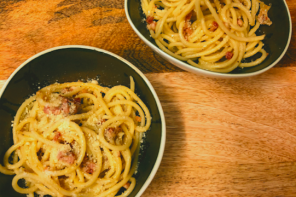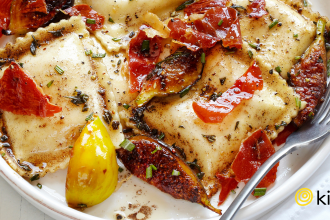Wine is made from grapes. We all know this. Red wine is made from red grapes. White wine is made from white grapes. Sometimes you’ll come across a blend of red varietals together, like this month’s Monsieur Moustache Bordeaux, and other times you’ll have a white blend.
But what if we told you it wasn’t all that uncommon to have a blend of red and white grapes? Ever had Champagne? What about a Syrah from the Rhône valley in Southern France? Or a Châteauneuf du Pape, perhaps? All of these wines have a combination of red and white grapes, although the degree to which they are blended varies from wine to wine.
Champagne, for example, is a mix of (white) Chardonnay and (red) Pinot Meunier and Pinot Noir. That (red) Syrah was likely fermented with (white) Viognier. A Châteauneuf du Pape can have more than 15 different varietals in it, some white and some red. So much of this delicate tinkering is left out in our simplified understanding of red versus white and can be easily overlooked.
There is one blend, though, that simply will not fit into the box of red or white. When it comes to Cviček you don’t have to be a master sommelier to taste that there’s something up.
Pronounced “Zvee-check,” the name translates to “very sour wine” in old Slovenian (which is fitting as this month’s Martinčič Cviček tastes startlingly like a red sour gummy). Cviček is one of Slovenia’s claim-to-wine-fames and is a national favorite. According to Eastern European wine expert Stetson Robbins, Cviček is popular not necessarily because it is the best wine produced in Slovenia, but because it has been part of the Slovenian identity for decades.
“Cviček is part of the Slovenian culture,” Stetson says, “and it’s a wine for partying – which is why it is drank cold and fast.”
The wine is made with a blend of (are you ready for this?) Kraljevina, Laski Riesling, Sylvaner, Zlahtnina, Ranfol and Lipna white grapes, Zametna Crnina, Franconian and Portugalka red grapes, as well as a few other lesser-known varietals. One vine of Zametna Crnina is planted 60 miles north of Dolenjsko, where the Martinčič Cviček is made, and is considered to be the oldest living vine in the world at roughly 400 years old.
Cviček is so ingrained in Slovenian culture that it is one of only two wines in the entire country to be marked with a PTP, the Slovenian version of a French AOC or Italian DOC label. This means there are a certain set of standards when it comes to the wine production that must be met to be considered a true Cviček. The mark of a PTP wine is basically a stamp of approval stating that all of the proper methods from growing to harvesting to bottling were used during production. If it’s good enough to get its own fancy title, then it’s good enough for us.
One aspect of the PTP regulation is that Cviček must be kept within a 10 percent alcohol by volume limit, making it the perfect wine for the prolonged celebrations that Stetson mentioned. And with a flavor profile bursting of strawberry-lemonade, Cviček is the type of wine that will simultaneously quench your thirst and make you want to drink more.
We recommend serving Cviček chilled and in large quantities, and can guarantee it will be a crowd-pleasing hit before you can say “Zametna Crnina.”









Why not let us know where we can get this wine. Is it even available in the US?
Hey Jeffery! It is available in the US! So glad you asked. Our friends over at Blue Danube Wine import out our favorite Cviček from Martinčič Winery in a 1 liter bottle!